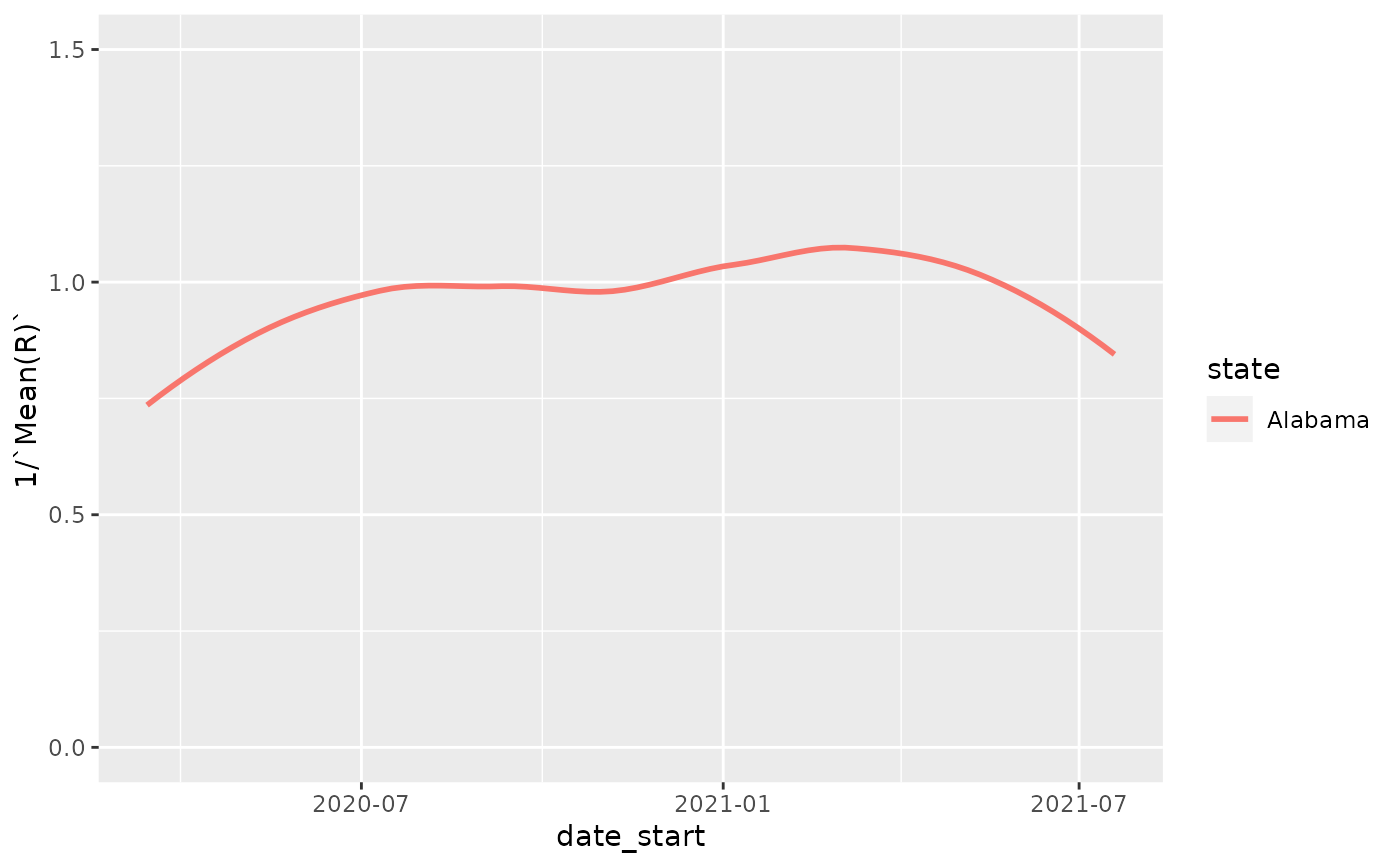Estimate R(t) for all locales in a case-tracking dataset
Source:R/estimate_Rt.R
bulk_estimate_Rt.RdThis function can estimate R(t) curves for all locations in a case-tracking dataset and return a stacked data.frame with the location details included. It is a convenience function for getting R(t) over a large dataset. Right now, nothing is done in "parallel", so this function is not going to be much (or any) faster than running on each location in a case-tracking dataset independently and then combining.
Arguments
- df
a data.frame containing at least a date column and a cases column, describing the cumulative cases at each date. The data.frame may contain additional columns that can be used to "group" the dates and cases to produce a set of R(t) curves.
- grouping_columns
character() vector specifying the grouping columns that will break
dfinto chunks for estimation (i.e., location, etc.). The default is normally correct and includes all columns except for date_column and case_column.- cases_column
character(1) the column in
dfthat includes the case counts of interest.- date_column
character(1) the column in
dfthat includes the date information about when cases reported.- ...
passed on to
estimate_Rt
Value
A "stacked" data.frame with the outputs from the R(t) estimation process
and associated location information. The actual columns returned for the
R(t) estimate will depend on the estimation_family parameter as well
as other parameters specific to each method.
See also
Other analysis:
estimate_Rt()
Other case-tracking:
align_to_baseline(),
beoutbreakprepared_data(),
combined_us_cases_data(),
coronadatascraper_data(),
covidtracker_data(),
ecdc_data(),
estimate_Rt(),
jhu_data(),
nytimes_county_data(),
owid_data(),
plot_epicurve(),
test_and_trace_data(),
usa_facts_data(),
who_cases()
Examples
library(dplyr)
nyt = nytimes_state_data() %>%
dplyr::filter(subset=='confirmed') %>%
dplyr::arrange(state,date)
head(nyt)
#> # A tibble: 6 × 5
#> date state fips count subset
#> <date> <chr> <chr> <dbl> <chr>
#> 1 2020-03-13 Alabama 00001 6 confirmed
#> 2 2020-03-14 Alabama 00001 12 confirmed
#> 3 2020-03-15 Alabama 00001 23 confirmed
#> 4 2020-03-16 Alabama 00001 29 confirmed
#> 5 2020-03-17 Alabama 00001 39 confirmed
#> 6 2020-03-18 Alabama 00001 51 confirmed
# this may produce warnings, but the processing
# will still be correct....
res = bulk_estimate_Rt(head(nyt,500),
estimation_family='epiestim',method = 'parametric_si',
config = list(mean_si=3.96, std_si=4.75))
#> Warning: All elements of `...` must be named.
#> Did you want `data = -c(grouping_columns)`?
head(res)
#> # A tibble: 6 × 17
#> state fips subset data t_start t_end `Mean(R)` `Std(R)` `Quantile.0.02…`
#> <chr> <chr> <chr> <list> <dbl> <dbl> <dbl> <dbl> <dbl>
#> 1 Alaba… 00001 confi… <tibble> 2 8 2.44 0.242 1.98
#> 2 Alaba… 00001 confi… <tibble> 3 9 2.00 0.183 1.66
#> 3 Alaba… 00001 confi… <tibble> 4 10 1.75 0.150 1.46
#> 4 Alaba… 00001 confi… <tibble> 5 11 1.81 0.139 1.54
#> 5 Alaba… 00001 confi… <tibble> 6 12 1.78 0.125 1.55
#> 6 Alaba… 00001 confi… <tibble> 7 13 2.39 0.130 2.14
#> # … with 8 more variables: `Quantile.0.05(R)` <dbl>, `Quantile.0.25(R)` <dbl>,
#> # `Median(R)` <dbl>, `Quantile.0.75(R)` <dbl>, `Quantile.0.95(R)` <dbl>,
#> # `Quantile.0.975(R)` <dbl>, date_start <date>, date_end <date>
colnames(res)
#> [1] "state" "fips" "subset"
#> [4] "data" "t_start" "t_end"
#> [7] "Mean(R)" "Std(R)" "Quantile.0.025(R)"
#> [10] "Quantile.0.05(R)" "Quantile.0.25(R)" "Median(R)"
#> [13] "Quantile.0.75(R)" "Quantile.0.95(R)" "Quantile.0.975(R)"
#> [16] "date_start" "date_end"
library(ggplot2)
ggplot(res, aes(x=date_start,y=1/`Mean(R)`,color=state)) +
geom_smooth(se=FALSE) + ylim(c(0,1.5))
#> `geom_smooth()` using method = 'loess' and formula 'y ~ x'
#> Warning: Removed 16 rows containing non-finite values (stat_smooth).
